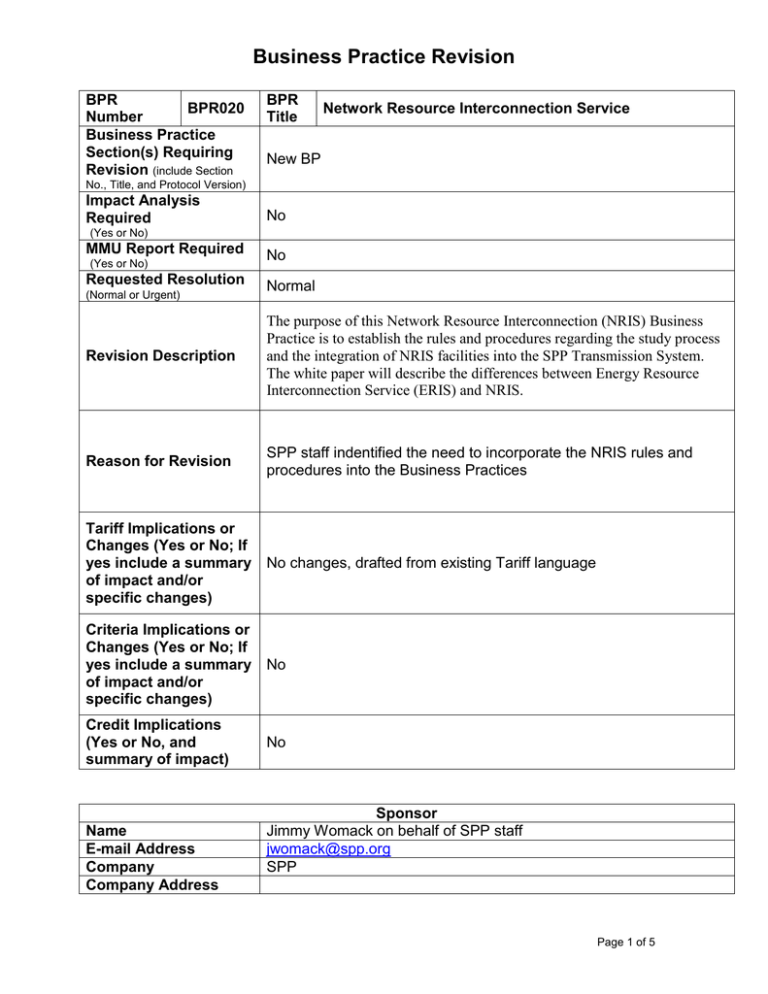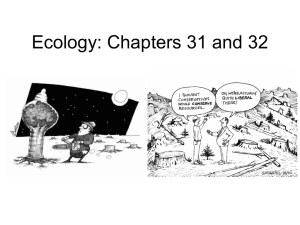BPR-020 Updated:2012-02-21 14:57 CS
advertisement

Business Practice Revision BPR BPR020 Number Business Practice Section(s) Requiring Revision (include Section BPR Title Network Resource Interconnection Service New BP No., Title, and Protocol Version) Impact Analysis Required No (Yes or No) MMU Report Required (Yes or No) Requested Resolution (Normal or Urgent) No Normal Revision Description The purpose of this Network Resource Interconnection (NRIS) Business Practice is to establish the rules and procedures regarding the study process and the integration of NRIS facilities into the SPP Transmission System. The white paper will describe the differences between Energy Resource Interconnection Service (ERIS) and NRIS. Reason for Revision SPP staff indentified the need to incorporate the NRIS rules and procedures into the Business Practices Tariff Implications or Changes (Yes or No; If yes include a summary No changes, drafted from existing Tariff language of impact and/or specific changes) Criteria Implications or Changes (Yes or No; If yes include a summary No of impact and/or specific changes) Credit Implications (Yes or No, and summary of impact) Name E-mail Address Company Company Address No Sponsor Jimmy Womack on behalf of SPP staff jwomack@spp.org SPP Page 1 of 5 Business Practice Revision Phone Number Fax Number 501-614-3244 Proposed Business Practice Language Revision X.XX NETWORK RESOURCE INTERCONNECTION SERVICE Network Resource Interconnection Service is provided By SPP pursuant to section 4.1.2 of the SPP OATT. Process and procedure guidelines have been established in order to attain a common understanding regarding the study process and the integration of NRIS facilities into the SPP Transmission System. Differences between Energy Resource Interconnection Service (ERIS) and NRIS are also identified. Business Practice CURRENT DAY RULES AND PROCEDURES: 1) Energy Resource Interconnection Service (ERIS) will be studied based on Attachment V of the SPP OATT, using various percentages of nameplate values spread to the entire SPP footprint based on the load ratio share of the Transmission Owner zones. Upgrades required to interconnect the ERIS generating facility will be cost allocated based on 20% TDF. 2) Network Resource Interconnection Service (NRIS) facilities will be studied based on two different analyses through Attachment V of the SPP Open Access Transmission Tariff (OATT), 1) using the nameplate amount of the resource to the interconnection host zone. Upgrades required to interconnect for analysis will be identified and cost allocated based on 3% TDF and 2) using various percentages of nameplate values spread to the entire footprint based on the load ratio share of the Transmission Owner zones. Upgrades required to interconnect for analysis will be identified and cost allocated based on 20% TDF. 3) 4) There is no difference between SPP Operations’ handling of NRIS and ERIS generating facilities. NRIS shows the customer’s intent to be a Designated Resource and ERIS does not. In addition, the higher level of integration attained by an NRIS unit may increase the likelihood of becoming a DR over that of an ERIS unit through avoidance of necessary congestion mitigation. However, there is no guarantee that additional upgrades will not be required to attain service as a DR. Page 2 of 5 Business Practice Revision 5) Neither NRIS nor ERIS guarantees transmission service or deliverability pursuant to Part II or Part III of the SPP OATT. Transmission service must be requested and studied through the same process as any other Designated Resource wanting to deliver energy to a specified point (Point-To-Point Transmission Service) or to a specified Network (Network Integrated Transmission Service). 6) Upgrades required to attain either NRIS or ERIS are not eligible for Base Plan funding. Base Plan funding determinations for Base Plan Upgrades are subject to limits stated in Attachments Z2 and J of the SPP OATT. 7) NRIS and ERIS generating facilities have equal abilities to request and receive Long-Term Service as Designated Resources in accordance with Attachment Z1 of the SPP OATT. NRIS and ERIS generating facilities have equal abilities to request and receive Short-Term Service based on the methodology as described in Attachment C and the reservation processing method described in Attachment AC of the SPP OATT. 8) The new SPP Day Ahead Market will allow NRIS and ERIS generating facilities to use the hedging rights being considered as long as the generating facility has been granted Long-Term Service or Short-Term Service longer than a month. All Long-Term Service and Grandfathered Agreements or Transactions will be eligible for hedging rights on a yearly basis at the first of each SPP fiscal year. Any remaining hedging rights will be allocated on a first come first served basis to Short-Term Service of a month or longer. Future Procedure consideration: 1) Current business rules will change once the new SPP Day Ahead Market is implemented. Definitions Designated Resource: Any designated generation resource owned, purchased or leased by a Transmission Customer to serve load in the SPP Region. Designated Resources do not include any resource, or any portion thereof, that is committed for sale to third parties or otherwise cannot be called upon to meet the Transmission Customer's load on a noninterruptible basis. Energy Resource Interconnection Service: An Interconnection Service that allows the Interconnection Customer to connect its Generating facility to the Transmission System to be eligible to deliver the Generation Facility’s electric output using the existing firm or Page 3 of 5 Business Practice Revision nonfirm capacity of the Transmission System on an as available basis. Energy resource Interconnection Service in and of itself does not convey transmission service. Firm Transmission Service: The highest quality (priority) service offered to customers under a filed rate schedule that anticipates no planned interruption. Grandfathered Agreements or Transactions: Grandfathered Agreements or Transactions include (1) agreements providing long term firm transmission service executed prior to April 1, 1999 and Network Integration Transmission Service executed prior to February 1, 2000; (2) bundled wholesale contracts (that reserve transmission as part of the contract); (3) short-term firm and non-firm point-to-point transmission transactions which were accepted and confirmed prior to the Effective Date; (4) existing or new contracts entered into by the Southwestern Power Administration on behalf of the United States for the use of transmission facilities of the Southwestern Power Administration that are constructed or acquired by purchase or other agreement, as authorized under Section 5 of the Flood Control Act of 1944, for the transmission of Federal Power; and (5) contracts executed before the Effective Date, regardless of term, entered into by the Southwestern Power Administration on behalf of the United States for the transmission of power or energy across transmission facilities owned and operated by the Southwestern Power Administration; (6)contracts entered into by a Nebraska publicpower entity prior to the transfer of functional control of its transmission facilities to the Transmission Provider; (7) existing contracts entered into by a Member which is a Nebraska public-power entity with any retail or wholesale electric utility customer that has a right under state law to obtain electric transmission service or energy service from such Member; and (8) new contracts entered into by a Member which is a Nebraska public-power entity with any retail or wholesale electric utility customer that has a right under state law to obtain electric transmission service or energy service from such Member to the extent that provision of service under the Tariff would not satisfy such Member’s obligation under state law. These agreements are set forth on the list which is Attachment W to this Tariff. Umbrella service agreements are specifically not Grandfathered. Long-Term Service: Long-Term Firm Point-To-Point Transmission Service or Network Integration Transmission Service of one year or longer in duration. Network Integration Transmission Service: Service that allows an electric transmission customer to integrate, plan, economically dispatch and regulate its network reserves in a manner comparable to that in which the Transmission Owner serves Native Load customers. This transmission service is provided under Part III of the SPP Tariff. Page 4 of 5 Business Practice Revision Network Resource Interconnection Service: An Interconnection Service that allows the Interconnection Customer to integrate its Generating Facility with the Transmission System in a manner comparable to that in which the Transmission Owner integrates its generating facilities to serve Native Load Customers as a Network Resource. Network Resource Interconnection Service in and of itself does not convey transmission service. Non-Firm Transmission Service: Transmission service that is reserved on an asavailable basis and is subject to curtailment or interruption. OATT: Open Access Transmission Tariff Part II: Tariff Sections 13 through 27 pertaining to Point-To-Point Transmission Service in conjunction with the applicable Common Service Provisions of Part I and appropriate Schedules and Attachments. Part III: Tariff Sections 28 through 36 pertaining to Network Integration Transmission Service in conjunction with the applicable Common Service Provisions of Part I and appropriate Schedules and Attachments. Point-To-Point Transmission Service: The reservation and transmission of capacity and energy on either a firm or non-firm basis from the Point(s) of Receipt to the Point(s) of Delivery under Part II of the SPP Tariff. Short-Term Service: Short-Term Firm Point-To-Point Transmission Service or Network Integration Transmission Service of less than one year in duration. SPP: The Southwest Power Pool, Inc. Transmission System: The facilities used by the Transmission Provider to provide transmission service under Part II, Part III and Part IV of the SPP Tariff. SPP OATT References: Part II Part III Attachment C Attachment J Attachment V Attachment AC Attachment Z1 & Z2 Page 5 of 5





